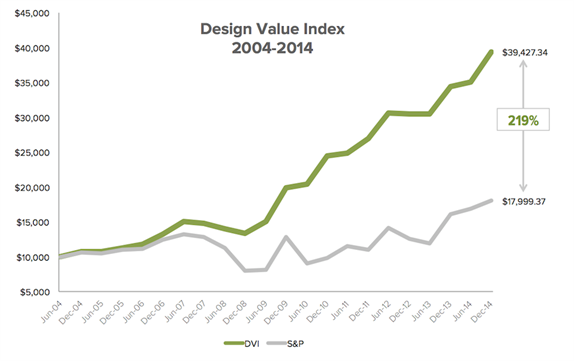Healthcare is an industry of increasing importance with our global ageing population. Health 2.0 looks to play a crucial role in the sectors future. Health 2.0 is focused on innovations and ideas to improve patient care. I attended an event held at Campus London, a Google space, on Health 2.0 and specifically User Experience (UX) Design to get a better understanding of its importance.
So what is UX design? UX design looks to improve user satisfaction along every touch point. Sounds like a great idea, but does it actually work? According to the Design Management Institute, design centric organisations outperform substantially.

There are many design centric companies such as Nike, IBM, Walt Disney, Proctor & Gamble and Starbucks to name a few. These firms try to reduce friction and increase satisfaction during their customers experience – be it shopping, shipping, or checkout. But can this be adapted to health – where patient interaction, and follow up care replace the traditional touch points?
Katie McCurdy, a patient and UX designer, addressed patient interaction by creating a visual prop to help communicate better with doctors. McCurdy suffers from a variety of autoimmune diseases. She shared an experience of organising a consultation, out of pocket, with a new doctor to help address some symptoms. The problem was that she had to communicate her life story of symptoms in one consultation. So she designed a timeline of her two major symptoms and their severity to help tell a coherent story. The prop she said helped her communicate in a structured way, eliminating the first few minutes of rambling and allowed a more efficient consultation.

McCurdy has gone on to create template tools for patients, including the timeline, and other visual props through a rigorous research, analysis, design, and feedback process.
She isn’t the only one who is taking on an active role in their healthcare. There is an emergence of d-patients, patients who engage in their own journey through creative design and analysis.
Flaredown for example aims to decode your chronic illness by tracking treatments, triggers, and even allowing patients to print out data in a doctor friendly summary. One innovative function of Flaredown is its ability to store users data anonymously. If your looking at starting a treatment, you can visit their Insights section and see realtime tracking of that treatment and results from their data bank.
Lenny Naar, speaker and design strategist, highlighted two key risks UX designers face. First is that health can actually be a life or death situation.

“There are two I.V. bags, one is a saline drip and the other an epidural which ones which? In 2006 shortly after giving birth a mother died because an epidural was put in her arm…was this the nurses fault? No, I would call it a design problem.”
Secondly once a problem is solved, its difficult to isolate the buyer. Going back to the saline epidural example, do you sell to the hospital, the shipping company, the manufacturer, the nurses? It can be very difficult to pinpoint the buyer let alone design an effective product.
Naar faces these risks every day at the Helix Centre. The Helix Centre is a joint venture between the Royal Academy of Arts and Imperial College London designing scaleable low cost innovations.
Their recent work is in asthma monitoring. An estimated 75% of UK asthma related hospital admissions are avoidable – This causes great strain on hospitals by raising costs and reducing capacity. The team at Helix are tackling this by replacing the archaic peak-flow meter and chart with Floot. Floot aims to increase users awareness through better understanding of asthma triggers as well as tracking flow through an interactive game. The game has been well received by children who are the most at risk segment.

Health 2.0 isn’t only focused on tracking. Gianluca Trombetta, founder of hearinghacks.com, created the first online community for hearing aid users. Trombetta walked us through the process of getting hearing aids and stressed the lack of psychological support and poor management of expectations. To address this he created a community for users who can openly engage and ask questions. The site will also soon be offering a mini-course “What audiologists don’t teach you”.
Be it creating visual props, tracking symptoms, or building online communities, Health 2.0 looks to play an important role in the sector. With an ageing population, innovation in patient care will become increasingly important. The challenge is to embrace UX design to not just outperform, but make a lasting impact in such a high risk sector.